Gian Lorenzo Bernini: The Genius Behind St. Peter’s Baldachin
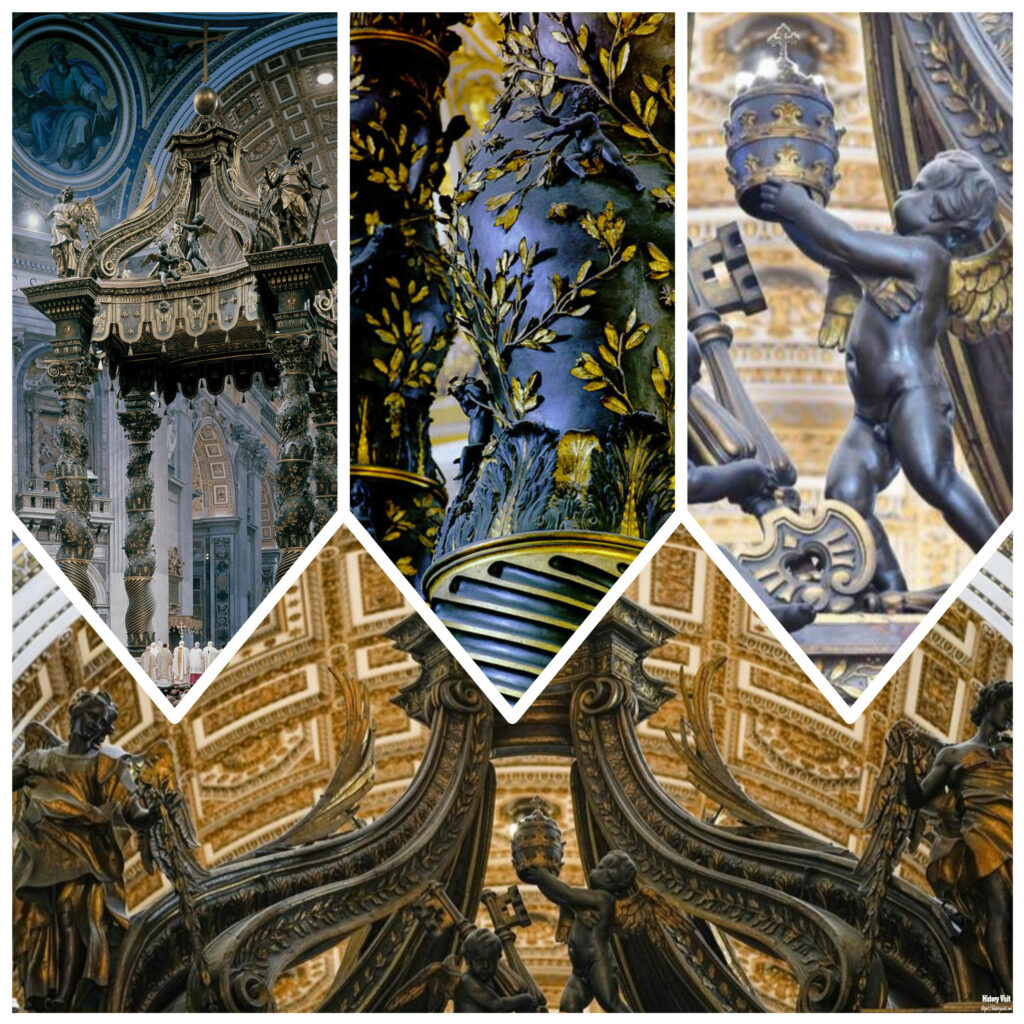
Introduction
Gian Lorenzo Bernini, one of the most influential artists of the Baroque era, left an indelible mark on the world of art and architecture with his innovative and dynamic creations. Among his many masterpieces, St. Peter’s Baldachin stands out as a monumental testament to his genius. Located in the heart of St. Peter’s Basilica in Vatican City, this grand bronze canopy encapsulates the grandeur and spiritual fervor of its time. Bernini’s work on the baldachin is not only a reflection of his extraordinary talent but also a symbol of the Catholic Church’s power and divine authority during the 17th century.
Commissioned by Pope Urban VIII, St. Peter’s Baldachin presented numerous challenges and required a blend of architectural prowess and sculptural artistry. Bernini’s ability to overcome these challenges and create a harmonious, awe-inspiring structure solidified his reputation as a master of the Baroque style. Through this work, Bernini managed to convey complex theological themes and historical continuity while pushing the boundaries of contemporary art and engineering. This article delves into the life and work of Gian Lorenzo Bernini, exploring the commission, symbolism, innovations, and lasting legacy of St. Peter’s Baldachin, and highlighting why it remains one of the most significant achievements in art history.
Gian Lorenzo Bernini: The Baroque Virtuoso
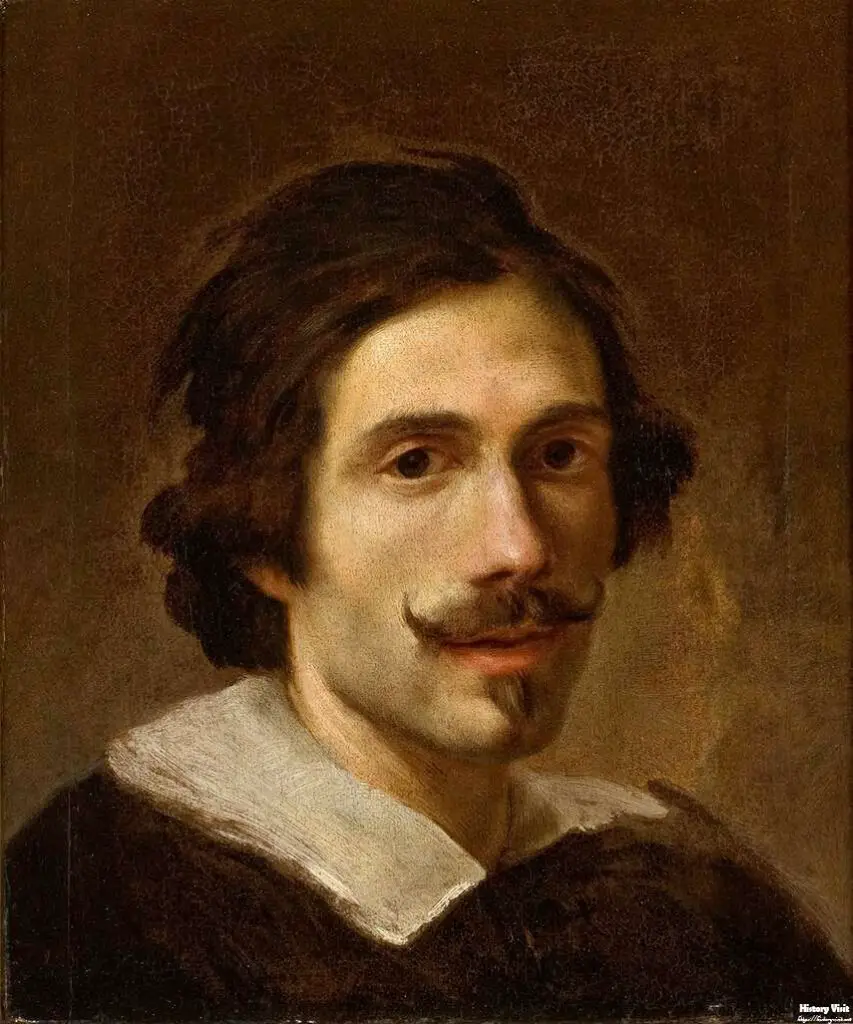
Gian Lorenzo Bernini (1598-1680) stands as one of the most influential figures in the history of Western art, particularly within the Baroque period. Born in Naples and later moving to Rome, Bernini was a prodigious talent, recognized for his exceptional skill in sculpture, architecture, and painting. His work is characterized by its dynamic compositions, dramatic expressions, and an unparalleled ability to infuse stone with life-like qualities. Bernini’s approach to art was holistic, often merging multiple disciplines to create cohesive, immersive experiences. His legacy is defined by his capacity to convey complex emotional narratives through a combination of intense realism and theatrical flair.
Bernini’s early works already showcased his remarkable ability to capture movement and emotion. By the time he was commissioned to work on St. Peter’s Baldachin, he had already established himself as a master sculptor with pieces like “David” and “Apollo and Daphne.” These works displayed his talent for depicting kinetic energy and intricate details. His ability to transform marble into seemingly soft, flowing forms laid the groundwork for his later works in bronze and architecture. Bernini’s mastery of these techniques made him the perfect choice for the ambitious project of St. Peter’s Baldachin.
His career was marked by close associations with powerful patrons, particularly the popes of the Catholic Church, who sought to use his talents to glorify the church and its doctrines. Under the patronage of Pope Urban VIII, Bernini had the opportunity to work on some of Rome’s most important religious and public monuments. This relationship was mutually beneficial: Bernini’s genius helped to propagate the Baroque style across Europe, while the church gained magnificent artworks that served both religious and propagandistic purposes. This collaboration reached its zenith with the creation of St. Peter’s Baldachin.
In Bernini’s later years, his reputation grew even more, influencing generations of artists and architects. His works continue to be studied and admired for their technical brilliance and emotional depth. Despite facing criticism and competition, Bernini maintained his status as a leading artist until his death in 1680. His contributions to the Baroque movement are undeniable, and his works remain central to the study of art and architecture. Bernini’s influence extended beyond his lifetime, shaping the aesthetic and spiritual environment of the period and beyond.
The Commission and Its Challenges
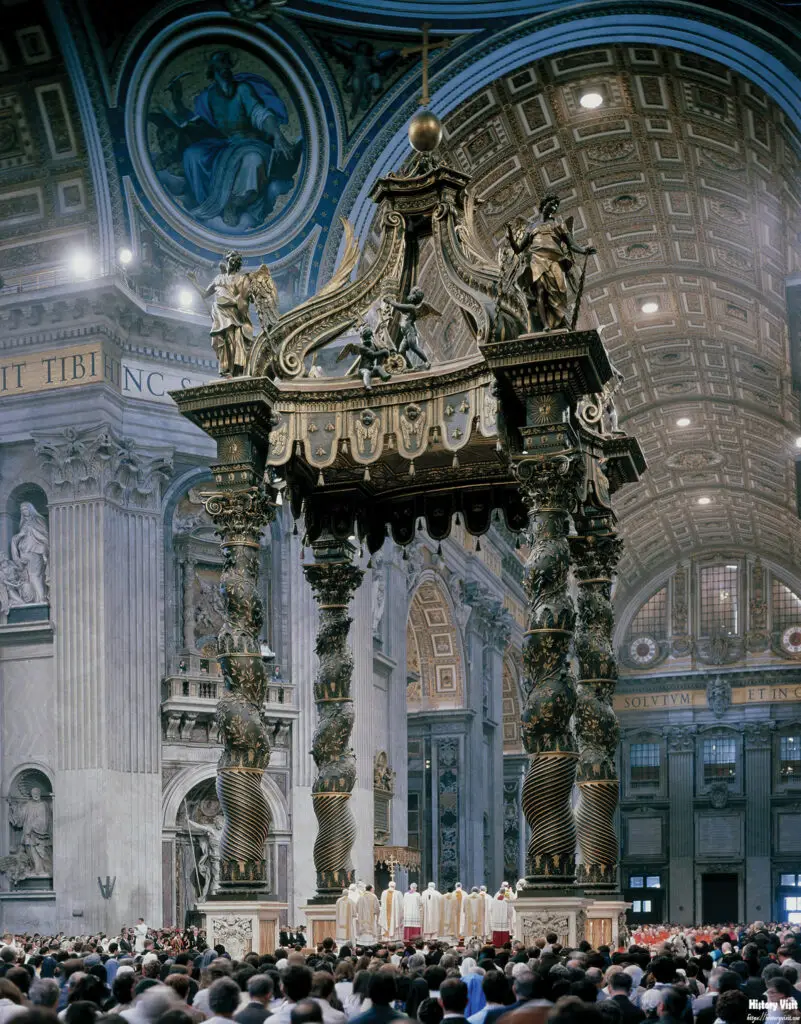
The commission for St. Peter’s Baldachin in 1623 by Pope Urban VIII was a monumental task that came with numerous challenges. The baldachin, also known as the baldacchino, was to serve as the focal point of St. Peter’s Basilica, directly above the tomb of St. Peter. This required a structure that was not only grand in scale but also rich in symbolic meaning and artistic innovation. Bernini was chosen for this task due to his proven ability to handle large-scale projects and his visionary approach to art and architecture. However, the enormity of this project presented unique difficulties that would test his skills and ingenuity.
One of the primary challenges was the sheer scale of the structure. The baldachin needed to be both massive and intricate, a combination that required innovative engineering solutions. Standing at nearly 98 feet tall, it was unprecedented in size for a bronze structure of its kind. Bernini had to ensure that the baldachin would not overwhelm the interior space of the basilica while still commanding attention. This required a delicate balance between architectural grandeur and structural stability, pushing the boundaries of contemporary engineering.
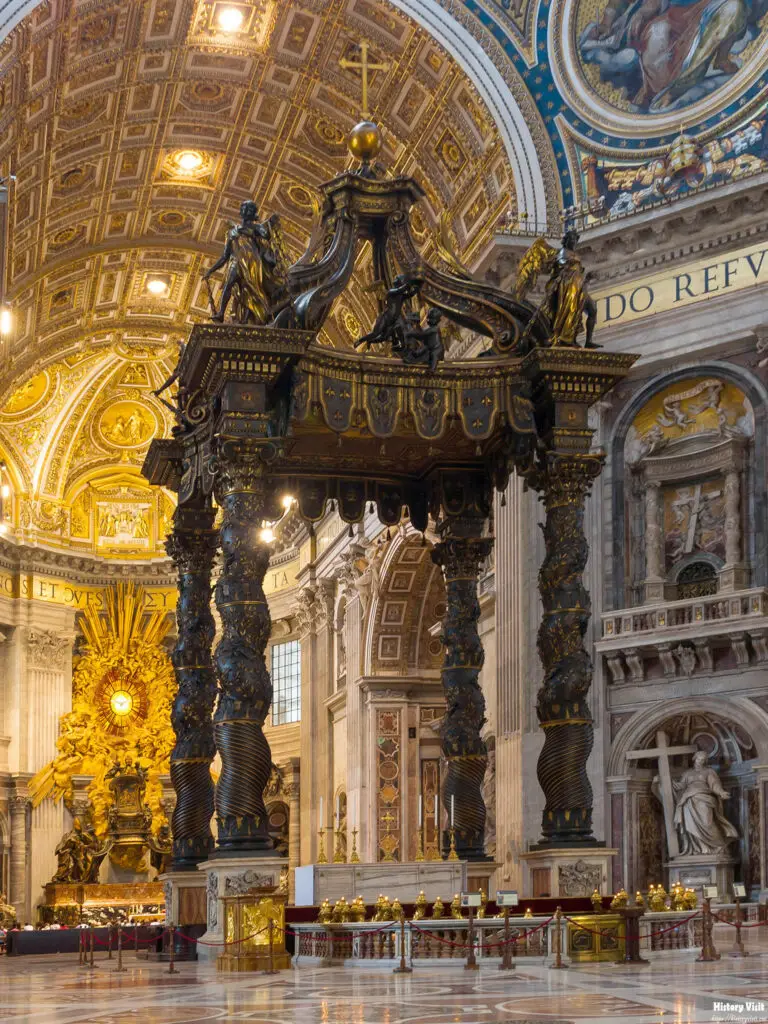
Additionally, working with bronze on such a large scale posed significant technical challenges. The casting and assembly of the massive twisted columns required exceptional precision and expertise. The columns themselves, with their distinctive spiraling grooves, needed to be both structurally sound and aesthetically pleasing. This was a complex process involving multiple stages of casting, assembling, and fine-tuning, often under the critical eye of the papal patrons. The logistical aspects of sourcing and transporting large quantities of bronze also added to the project’s complexity.
Despite these challenges, Bernini’s innovative spirit and meticulous attention to detail ensured the successful completion of the baldachin. His ability to collaborate with a team of skilled artisans and his relentless pursuit of perfection were key factors in overcoming the numerous obstacles. The result was a stunning masterpiece that not only fulfilled its liturgical function but also set a new standard for ecclesiastical art and architecture. The successful execution of such a challenging project cemented Bernini’s reputation as a genius of his time and left a lasting impact on the world of art.
Symbolism and Artistic Brilliance
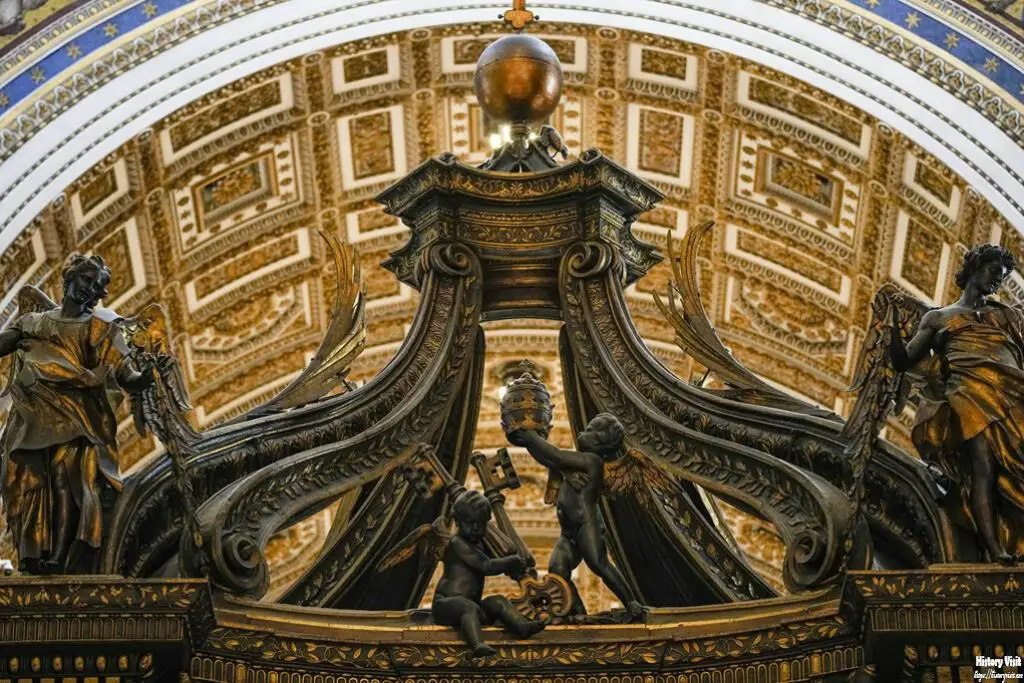
St. Peter’s Baldachin is rich with symbolic meaning, each element meticulously designed to convey a deeper narrative that aligns with the spiritual and doctrinal themes of the Catholic Church. The twisted columns, known as Solomonic columns, are a direct reference to the ancient columns believed to have adorned Solomon’s Temple in Jerusalem. This allusion serves to connect the New Testament Church with its Old Testament roots, emphasizing continuity and divine legitimacy. The spiraling design of the columns also creates a sense of upward motion, directing the viewer’s gaze towards the heavens and reinforcing the spiritual ascent towards God.
The columns are adorned with a variety of intricate details, including vines and laurel leaves, which symbolize growth, victory, and eternal life. These elements are not merely decorative but are imbued with theological significance, reflecting the church’s triumph over sin and death through Christ. At the top of the columns, cherubs and angels add a layer of divine presence, enhancing the sacred atmosphere of the baldachin. These angelic figures appear to be in motion, their dynamic poses contributing to the overall sense of movement and life that characterizes Bernini’s work.

The canopy itself, or the baldachin’s roof, features the Barberini family crest, which includes three bees. This crest signifies the patronage of Pope Urban VIII, whose family name was Barberini. The bees symbolize industriousness, unity, and the church’s role as a nurturing hive for its followers. This inclusion not only honors the pope but also serves as a reminder of the church’s mission and the papacy’s role in guiding and protecting the faithful. The use of personal and familial symbols in such a prominent religious context highlights the interconnectedness of faith, art, and personal legacy in Bernini’s work.
Moreover, the entire structure of the baldachin serves as a monumental frame for the altar of St. Peter’s Basilica, enhancing the sacredness of the space. The use of bronze, a material associated with durability and permanence, underscores the eternal nature of the church’s teachings. The interplay of light and shadow on the surface of the bronze adds a dramatic effect, typical of Baroque art, creating an atmosphere of awe and reverence. Through these artistic choices, Bernini not only achieved a masterpiece of design but also conveyed a profound theological message that continues to resonate with viewers to this day.
Innovations and Legacy

One of the most remarkable innovations associated with St. Peter’s Baldachin was Bernini’s use of bronze, particularly the decision to repurpose metal from the ancient Roman Pantheon. This act of transformation carried significant symbolic weight, representing the triumph of Christianity over paganism. By melting down the bronze from a structure dedicated to all Roman gods and using it to create a canopy for the tomb of St. Peter, Bernini and the church made a powerful statement about the continuity and supremacy of Christian faith. This innovative reuse of materials not only solved practical problems related to sourcing such a large quantity of bronze but also infused the new structure with historical and spiritual resonance.
Bernini’s approach to the baldachin’s design was also revolutionary in its integration of architecture and sculpture. Rather than treating these disciplines as separate, Bernini fused them into a seamless whole, creating a structure that was both architecturally sound and artistically expressive. This holistic approach allowed for a greater degree of creative freedom and resulted in a more cohesive and impactful work. The twisted columns, dynamic figures, and intricate details all contribute to a unified vision that enhances the overall aesthetic and spiritual experience of the basilica.
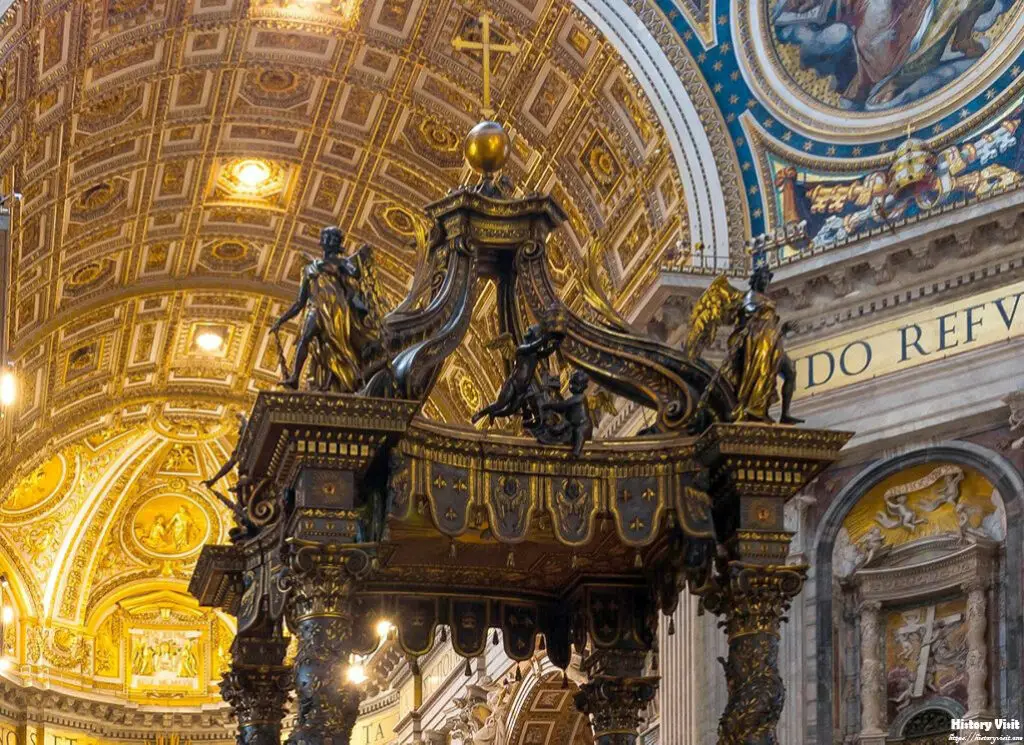
The legacy of St. Peter’s Baldachin extends far beyond its immediate visual impact. It set new standards for ecclesiastical art and architecture, influencing countless artists and architects in the Baroque period and beyond. Bernini’s innovative techniques and bold artistic vision inspired a generation of artists to explore new possibilities in their work. The baldachin became a model for other large-scale religious commissions, demonstrating how art could serve both aesthetic and doctrinal purposes. Its success also solidified Bernini’s reputation as a leading figure in the Baroque movement, ensuring his influence would be felt for centuries.

Today, St. Peter’s Baldachin remains a central piece of Bernini’s artistic legacy and a key attraction for visitors to St. Peter’s Basilica. Its grandeur and intricacy continue to inspire awe and admiration, while its symbolic meanings provide a rich tapestry of theological and historical references. The baldachin stands as a testament to Bernini’s genius, his ability to transcend the boundaries of different artistic disciplines, and his enduring impact on the world of art. It encapsulates the essence of the Baroque era, with its emphasis on dramatic expression, movement, and the interplay of light and shadow, ensuring its place in the annals of art history.
Conclusion
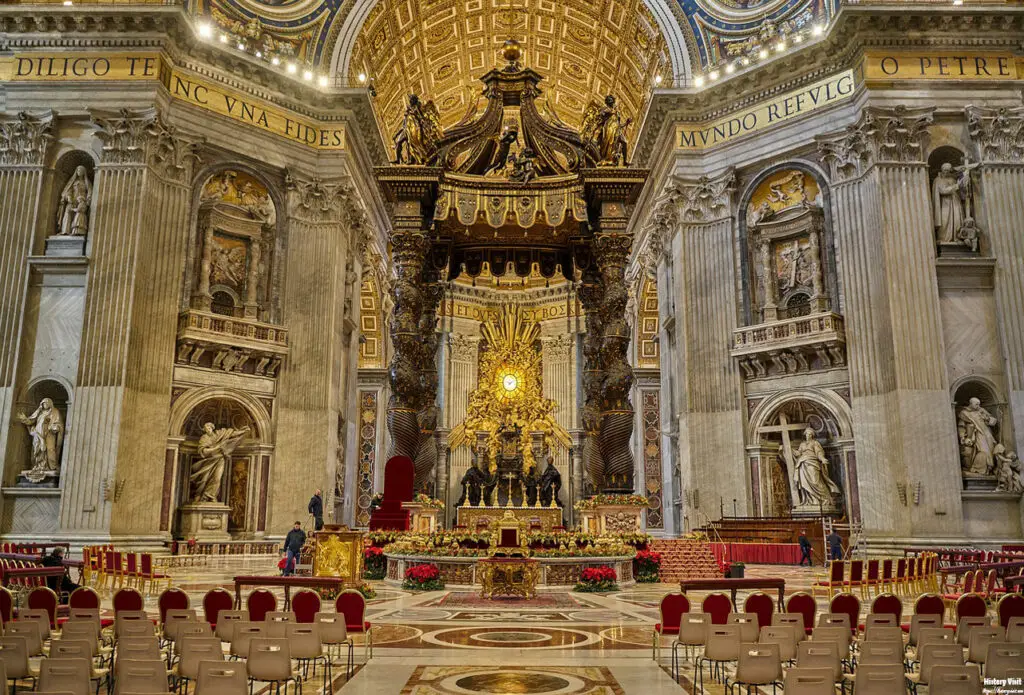
Gian Lorenzo Bernini’s St. Peter’s Baldachin is a masterpiece that epitomizes the artistic and spiritual grandeur of the Baroque era. Through his innovative use of bronze and his ability to integrate architecture with sculpture, Bernini created a work that transcends mere decoration. The baldachin not only marks the tomb of St. Peter but also symbolizes the continuity and authority of the Catholic Church, blending ancient traditions with contemporary expressions of faith. Bernini’s vision and technical prowess ensured that the baldachin would become a central focal point of St. Peter’s Basilica, captivating the faithful and art lovers alike.
Bernini’s work on St. Peter’s Baldachin stands as a testament to his genius and his lasting impact on the world of art. His ability to convey movement, emotion, and spiritual symbolism within a single structure highlights his unique talent and visionary approach. The baldachin remains a crucial part of Bernini’s legacy, showcasing his contributions to Baroque art and architecture. Today, it continues to inspire and awe visitors from around the world, a fitting tribute to Gian Lorenzo Bernini’s enduring influence and unparalleled artistry.


